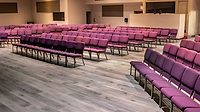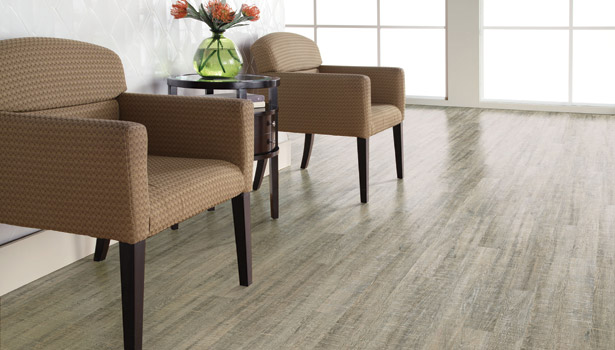With Style, Durable Construction, LVT a Growing Force in Commercial






Hospitals, schools, corporate offices, retail shops – what do they all have in common? They all endure the strain of high traffic. Businesses in the commercial sector need a floor that can withstand the toll of the public’s feet. LVT can offer up a solution in an affordable price range and a wide array of colors, patterns and textures. With these features, LVT has become an appealing option for the commercial sector.
Using LVT in a commercial location allows for many options according to Bud Katzmann, commercial flooring product manager for Armstrong World Industries, “The manufacturing process enables designs that replicate other materials like stones, metals, woods and specialty graphics. The combinations of colors, patterns and sizes means facility managers and designers have endless combinations for just the right impression.”
According to Angelina Cebrian, IVC US’s marketing communications manager, “With LVT, you’re able to achieve a natural hardwood or tile look without the expense or worry. Another way to think of it is LVT is the hard-surface version of carpet tile. It’s modular, and you can easily repair or replace a luxury vinyl plank or tile without replacing the entire floor.”
Natalie Jones, Mannington’s vp of commercial brand development and creative product, considers LVT highly versatile. “LVT comes in a range of aesthetics – often inspired by abstract patterns and textiles – as well as in a range of formats.” David Sheehan, Mannington’s vp of commercial LVT, agreed. “If a designer can imagine it, then Mannington can create it, in a wide range of styles.”
The latest product from LSI mimics the look of a hockey rink – created for a store that focused predominantly on hockey equipment. “The white ice was colored with blue and red to create the lines on the rink. LSI loved the pattern so much that we have added it to our standard imagination collection,” said Rick Moffatt, creative director and presidentof LSI.
Aspire by Metroflor mimics the look of ceramic and stone in three different collections: Novara, Siracusa and Naples. The groutable tile gives the LVT a realistic look by adding real grout in between each tile. Aspire floats over most existing subfloors, making installations quick and easy. The installers are able to lay the floor, grout and cleanup all within the same day, according to the company.
LVT can be used in almost any location, retail, healthcare, classrooms … you name it, and it can probably go there, too. “The success of any resilient flooring is selecting the right floor for a particular space by understanding the customer’s durability requirements and preferences,” said Katzman.
Most LVT products feature a wear-resistant top layer that helps prevent any heavy wearing on the floor and also prevents the floor from being high maintenance. After a few years of use the floor typically needs to be polished in order to keep the floor in good working condition. “The LSI LVT is made durable through a multi-layer manufacturing process, quality components and a glass re-enforced UV-cured wear layer of 0.7mm thickness. This technology allows for a ‘mop and go’ maintenance solution,” said Moffatt.
USFloors has recently taken the concept of luxury vinyl tile in a different direction with the launch of their new Stratum Engineered Luxury Vinyl Planks and Tiles. Stratum is a hybrid floor that offers features of both LVT and laminate. Stratum does not swell when it is exposed to water and works well in wet areas; it also doesn’t swell with changes in temperature or humidity, the company said. IVC US is also experimenting with the construction of LVT. The company recently launched Moduleo, which Cebrian says is the only LVT product currently on the market featuring a double-fiberglass core. “This double fiberglass core provides Moduleo with maximum dimensional stability, strength and flexibility while ensuring an easy and trouble-free installation process; offering both click and glue down installation methods.”
LVT also offers a green story. Armstrong’s Striations and Migrations Biobased Tile, for example, both contain rapidly renewable, U.S.-grown plant materials as well as 10% pre-consumer recycled content.
Looking for a reprint of this article?
From high-res PDFs to custom plaques, order your copy today!











